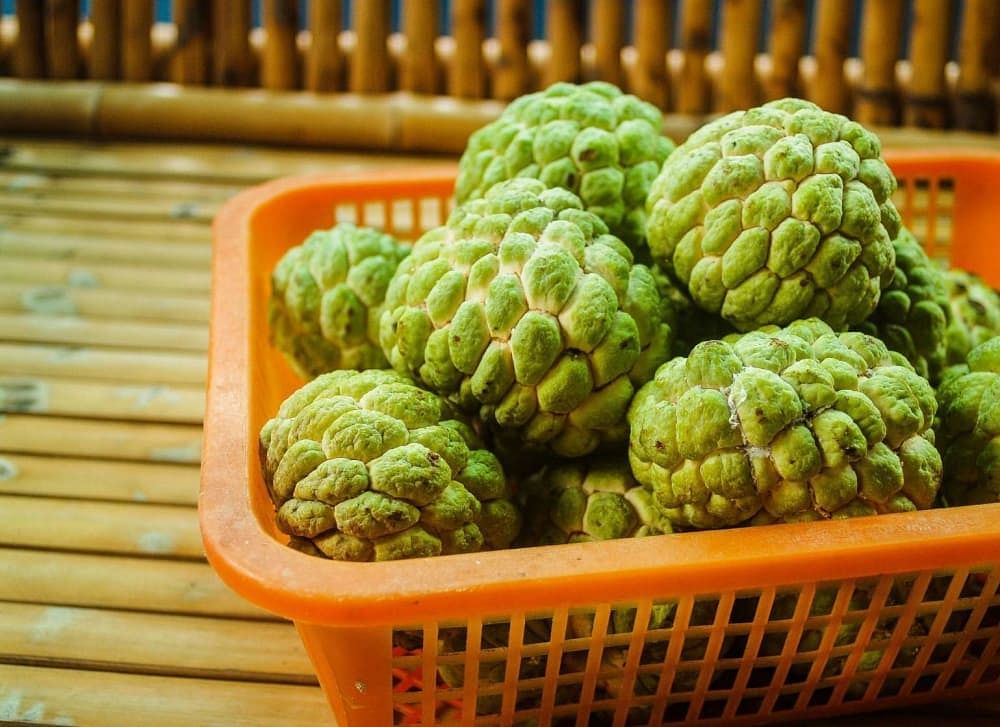Custard apples are known by many other names such as sitafal, cherimoya, sugar apple, etc. It is not a very popular fruit, especially in India. However, it has many health benefits. Continue reading to find out more about this creamy, sweet-flavored fruit.
What Is Custard Apple (Sitafal)?
Sitafal or Custard Apple is a green-colored fruit found in high-altitude tropical areas. It has leather skin that looks like scales and has sweet flesh with a creamy texture. Its taste resembles other tropical fruits such as pineapple and banana.
People often eat sitafal raw with a spoon after removing the outer layer. It is named custard apple because its creamy texture is similar to that of custard. It has a cone-like shape.
Nutrients in Custard Apple (Sitafal)?
Custard apple contains the following nutrients:
- 38% of Vitamin C
- 22% of Magnesium
- 15% of Vitamin B6
- 6% of Iron
Custard Apple Benefits
Here are some major sitafal benefits that make it worth eating:
1. Rich source of antioxidants
High oxidative stress in your body could cause long-term illnesses such as cardiovascular problems and cancer. Sitafal has compounds regarded as powerful antioxidants like kaurenoic acid, vitamin C flavonoids, and carotenoids. They neutralize oxidizing agents and reduce the risk of these chronic diseases.
2. Elevates mood
Custard apple is a rich source of vitamin B6 or pyridoxine, which boosts the production of dopamine and serotonin. These neurotransmitters improve the mood of a person. Their deficiency causes stress, depression, and other mental health issues. 160 grams of custard apples contains 24% of recommended daily intake of vitamin B6.
3. Promotes Eye Health
Lutein in Sitafal is a powerful antioxidant found in the eyes. It protects against free radicals and prevents diseases like cataracts, macular degeneration, etc., by maintaining good eye health.
4. Controls Blood Pressure
Potassium and magnesium are found in abundance in Sitafal. They dilute blood vessels which help in reducing blood pressure. Thus they maintain a healthy heart and prevent cardiovascular diseases like strokes.
5. Improves Digestive System
Sitafal or Custard Apple has fiber content that adds substance to the stool. It, thus, helps in managing digestive issues like constipation and diarrhea as it eases the food passage through the intestine. Also, the soluble fiber in custard apple facilitates fermentation for making short-chain fatty acids. These fatty acids protect the digestive tract from inflammatory diseases like Crohn’s disease and ulcerative colitis, as well as provide energy to the body.
6. Possesses anti-cancer properties
It has been observed that flavonoids like catechin, epicatechin, and epigallocatechin in custard apple block the growth of cancerous cells. A comparative study on the "effect of epicatechin on cancerous cells" demonstrated that it helps in stopping the growth of cancerous cells in the bladder. One of the other research showed that catechin in custard apple prevents replication of breast cancer cells. Also, some studies corroborate that those who eat the flavonoids-rich diet are at a lower risk of developing cancer. However, more research needs to be conducted in this area to fully understand the usefulness of Sitafal in treating this disease.
7. Prevents Inflammation
Custard apple has kaurenoic acid and other such anti-inflammatory compounds. They prevent illnesses like cancer and heart diseases that could be caused because of chronic inflammation. This fruit also boosts the production of compounds possessing anti-inflammatory properties like catechin, epicatechin, and epigallocatechin, according to one study. Another study conducted on mice concluded that epicatechin reduces inflammatory marker C reactive protein in the blood. This protein increases the risk of cardiovascular diseases by hardening and narrowing arteries.
8. Boosts Immunity
Sitafal is a rich source of Vitamin C, a nutrient that improves immunity and protects from diseases. Its deficiency leads to a high risk of infection. A study also suggested that vitamin C might prove helpful in decreasing the duration of the common cold.
9. Protects Against Arthritis
When acid gets deposited in the joints, it causes arthritis and rheumatism. Magnesium, which is found in abundance in custard apples, maintains the water balance in the body and thus helps in removing acid from joints. It also provides strength to the muscles. Additionally, calcium in Sitafal is considered good for bone health.
10. Maintains Skin Health
Your skin looks elastic, plump, smooth, and young because of a protein called collagen. As you grow old, collagen production decreases, causing wrinkles, fine lines, and sagginess. Custard apple boosts the production of collagen to keep your skin young and healthy. Its compounds also decelerate collagen breakdown. Antioxidants in Sitafal delay aging signs and blemishes by fighting off oxidative stress.
Custard Apple in Pregnancy
Various uses of custard apple during pregnancy are:
- Vitamin B6 reduces nausea and morning sickness.
- Neural sugar and calories help in gaining weight.
- Potassium and magnesium regulate blood pressure.
- Dietary fiber prevents the risk of constipation and diarrhea.
- Magnesium maintains heart health and reduces stress.
- Fruit provides nutrition for fetus organ development like blood vessels, skin, and tendon.
- Antioxidants build immunity.
- Copper helps in reducing the chances of miscarriage and premature delivery.
Although there are the above-mentioned benefits of custard apples in pregnancy, expecting mothers should be careful while consuming them if they are allergic or overweight to avoid complications.
Custard Apple and Diabetes
There's a myth going around that a diabetic person should not eat custard apples as it increases blood sugar levels because of high sugar content. However, this isn't true. Custard apple is a low glycemic index food, and hence its consumption won't lead to an increase in blood sugar level. On the contrary, studies suggest that such fruits are considered good for diabetic people since they provide necessary nutrients without raising the blood sugar level.
Custard Apple for Weight Loss
One gram of custard apple has only 1 calorie of energy. Thus its consumption won't increase your weight. Also, it has high fiber content. So you will feel fuller quickly. Hence your calorie intake will be reduced, which may lead to weight loss in the long run.
Red Custard Apple Benefits
Red Custard Apple closely resembles Sitafal or Sugar Apple. However, both have slightly different textures and colors. As the name suggests, red custard apple is red whereas sitafal is green colored. The nutrition content of both fruits is more or less the same, and hence their benefits are also similar.
Here are some benefits of red custard apple:
- Rich source of energy
- Fights depression
- Helps in soothing asthma
- Boosts immune system
- Reduces risk of anemia
- Maintains a healthy heart
- Regulates cholesterol
Custard apple leaves benefit in many ways too. They have fiber, antioxidants, and anti-inflammatory properties. That’s why their decoction is used for treating urinary tract infections and dysentery. They also keep lice away when rubbed on the floor (a common practice in Mexico).
Types of Custard Apple
Some popular varieties of custard apple are as follows:
1. Pierce Cherimoya
This tropical-flavored variety of custard apple is found natively in Ecuador, Peru, and Northern Andress. Its size is comparatively bigger than the other varieties of custard apple. Pierce Cherimoya has juicy flesh.
2. Atemoya
This custard apple is a cross between cherimoya and sugar apple. In Taiwan, it is more popularly known as pineapple sugar apple. Atemoya has a green-colored outer layer which is soft and bumpy. It has a round or heart-like shape.
3. McPherson Cherimoya
Its fruits are medium to large with fewer seeds, and the taste is similar to that of banana. It has a dark green-colored outer layer. McPherson is most commonly found in California.
4. White Cherimoya
This is the smallest variety of custard apples. It tastes very sweet like papaya and has a white-colored juicy pulp.
5. Sugar Apple
It is a dark-green-colored custard apple grown widely in Taiwan, Indonesia, Thailand, and other parts of South Asia. Its fruits are also known as sweetsops. Sugar apple's flesh is white and tastes sweet.
6. Mountain Soursop
Its outer layer is yellow or light green, and pulp is lemon yellow. Mountain soursop is commonly found in the Amazon, Caribbean Islands, and Central America. This custard apple's leaves look glossy, and its fruit tastes sour and bitter, unlike other varieties.
7. El Bumpo
This cherimoya gets the name El Bumpo due to the bumps on its skin. El Bumpo is known as a “fruit that tastes heavenly” because of its creamy flavor. That’s why it is included in the UC South Coast Research and Extension Center tasting organized for 15 custard apple varieties.
How To Eat Custard Apple
You can eat ripe custard apples directly by scooping out the inner flesh or pulp with a knife or spoon. Also, you can use it to make various delicious dishes. Here are some other ways to consume custard apples:
1. Custard Apple in Baked Goods
- Replace custard apple with an apple in fruit salad, tea cakes, and homemade pies. It adds a unique tangy taste with a sweet flavor and richer consistency to the baked goods.
- Applesauce and other fruit dishes can also be prepared using custard apples.
- It can also be used as a topping for parfaits, oatmeal, and pancakes.
2. Custard Apple Smoothie
- Mix some fresh fruits, vegetables, yogurt, juice or milk, crushed ice, along with custard apple in a blender.
- Sweet fruits like peaches, bananas, strawberries, and mango taste good with custard apple because of the sharp aftertaste that it leaves in the mouth.
3. Custard Apple in Savoury Dishes
- You can mix chopped custard apples in chicken salad, stir fry, and vegetarian curries. They provide contrasting pleasant sweetness to these salty and spicy dishes.
- You can also replace apple with custard apple in pork chops and chicken sausages.
Custard Apple Origin
Custard apple was introduced to tropical Africa in the early 17th century. In South Africa, it is cultivated as a dooryard fruit tree. However, its origin roots are considered to be in the West Indies. From there, it was carried to Central America and then to Mexico. It is also grown to the far south of Brazil and Peru. Its population is the largest in the Bahamas, Bermuda, and southern Florida.
Custard apple has been grown very commonly in Southeast Asia, the Philippines, and the east coast of Malaya. It is cultivated only in Calcutta in India, but its wild varieties are found in many regions.
Custard Apple Side-effects
The benefits of eating custard apple are many, but its unregulated consumption may cause side-effects such as:
- It has a toxin called annonacin that could negatively impact your nervous system and brain.
- Consuming its seeds and skin increases the risk of Parkinson’s disease as they have high concentrations of annonacin.
- Custard apple seeds and skin may also cause allergies to skin, redness, or damage to the eyes due to the presence of toxins.
- Too much consumption could increase body fat more than needed and make you obese.
Summing Up on Custard Apple Benefits
Sitafal price is higher in India as compared to other fruits because it is not widely cultivated in many local regions. However, its various health benefits make the fruit worth consuming. It would make your diet more balanced and nutrient-rich. Custard apple disadvantages might be few, but those can be avoided if you are careful with the consumption.
FAQs
1. What Happens if We Eat Custard Apple Daily?
Ans. You can eat custard apple daily as it offers many health benefits like boosting the digestive system and immune system, promoting eye health, and controlling blood sugar levels. However, you shouldn’t eat its skin and seeds as they contain a toxin called annonacin.
2. Which Vitamin Is Present in Custard Apple?
Ans. Vitamin C is found in abundance in custard apples.
3. Does Eating Custard Apple Cause Cough?
Ans. Custard apples may cause cough in people having pollen allergies, also known as pollen fruit syndrome.
References
- University of Granada, September, 2011; Low zinc and copper levels might cause spontaneous abortion, study suggests - https://www.sciencedaily.com/releases/2011/09/110928105859.htm
- Harri Hemilä, Elizabeth Chalker, January 2013; Vitamin C for preventing and treating the common cold - https://pubmed.ncbi.nlm.nih.gov/23440782/
- Martine Morrison, Roel van der Heijden, Peter Heeringa, Eric Kaijzel, Lars Verschuren, March 2014; Epicatechin attenuates atherosclerosis and exerts anti-inflammatory effects on diet-induced human-CRP and NFκB in vivo - https://pubmed.ncbi.nlm.nih.gov/24529136/
- Yacong Bo, Jinfeng Sun, Mengmeng Wang,Jizhe Ding, Quanjun Lu, and Ling Yuan, April 2016; Dietary flavonoid intake and the risk of digestive tract cancers: a systematic review and meta-analysis - https://www.ncbi.nlm.nih.gov/pmc/articles/PMC4845003/
- Navindra P Seeram, Yanjun Zhang, Muraleedharan G Nair, 2003; Inhibition of proliferation of human cancer cells and cyclooxygenase enzymes by anthocyanidins and catechins - https://pubmed.ncbi.nlm.nih.gov/12925310/
- Brian J Philips, Christian H Coyle, Shelby N Morrisroe, Michael B Chancellor, August 2009; Induction of apoptosis in human bladder cancer cells by green tea catechins - https://pubmed.ncbi.nlm.nih.gov/19729851/
- Sónia A O Santos, Carla Vilela, João F Camacho, Nereida Cordeiro, Manuela Gouveia, Carmen S R Freire 5, Armando J D Silvestre Profiling of lipophilic and phenolic phytochemicals of four cultivars from cherimoya (Annona cherimola Mill) - https://pubmed.ncbi.nlm.nih.gov/27283704/












